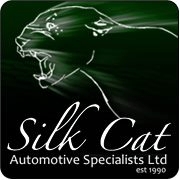 Founded as the Swallow Sidecar Company in 1922, by two motorcycle enthusiasts, Sir William Lyons, William Walmsley, the SS Jaguar name first appeared on a 2.5 litre saloon in 1935, sports models of which were the SS 90 and SS 100.
Founded as the Swallow Sidecar Company in 1922, by two motorcycle enthusiasts, Sir William Lyons, William Walmsley, the SS Jaguar name first appeared on a 2.5 litre saloon in 1935, sports models of which were the SS 90 and SS 100.
The Jaguar name was given to the entire company in 1945 when the “SS” name was dropped due to its association with Germany’s SS military organization much publicized and in Britain greatly reviled during and following World War I. Cash was short after the war and Jaguar sold to Rubery Owen the plant and premises of Motor Panels, a pressed steel body manufacturing company which had been acquired in the late 1930s when growth prospects had seemed more secure. Nevertheless, Jaguar achieved relative commercial success with their early post war models: times were also tough for other Coventry based auto-makers and the company was able to buy from John Black’s Standard Motor Company the plant on which Standard had built the six cylinder engines which, hitherto, they had been supplying to Jaguar
Jaguar made its name by producing a series of extremely eye-catching sports cars, in the XK 120 of 1949, developed into XK 140 and XK 150, and the E Type (or XKE in the US) of 1961. These were all successful and embodied Lyons’ mantra of ‘value for money’. They were also highly successful on the international stage of motorsport, a path followed in the 1950s to prove the engineering integrity of the company’s products.
Jaguar’s sales slogan for years was “Grace, Space, Pace”: a mantra epitomised by the record sales achieved by the MK VII, IX, Mks I and II saloons and later the XJ6.
The core of Bill Lyon’s post World War II success was the Twin Cam Straight Six Cylinder Engine—a design conceived pre-war and realised while design staff at the Coventry plant were dividing their time between fire-watching (Coventry being a main industrial centre was a prime target for the Luftwaffe) and designing the new power plant.
To place this in focus, pre-war, a benchmark for racing and competition engines was the “Double Knocker”, or Twin Cam engine: Jag’s new engine was a hemispherical cross-flow cylinder head with valves inclined originally at 60 Degrees (Inlet) 45 Degrees (Exhaust) and later standardized to 90 Degrees for both Inlet and Exhaust.
As octane ratings of fuel were relatively low from 1948 onwards, three different pistons configurations were offered: Domed (High Octane) Flat (Medium Octane) and Dished (Low Octane).
The main designer, William “Bill” Heynes, ably assisted by Walter “Wally” Hassan was determined to design the Twin OHC unit. Bill Lyons agreed over misgivings from Hassan. The sheer concept of applying what had hitherto been considered a racing or low-volume and cantankerous engine, needing constant fettling into a reasonable volume production everyday saloon cars was brave.
And simultaneously, brilliantly inspired.
And the subsequent engine was the mainstay power plant of Jaguar, used in the revolutionary XK 120, Mk VII Saloon, Mk I and II Saloons and XK 140 and I50 as well as the stunning E Type, itself a development from the race winning and Le Mans conquering C and D Type Sports Racing cars.
(The E Type was the production version of the short-lived XKSS: a road-legal version of the famed D Type Sports Racing car and built mainly to use up redundant D Type Chassis. Production of the XKSS was cut short when a disastrous fire decimated essential jigs and tooling.)
Few engines have demonstrated such ubiquity and longevity: the Twin OHC “XK Engine”, as it came to be known, was used in the new Jaguar XJ6 saloon in 1969 (which use continued right up until 1992!), and additionally employed as the power plant (in this case typed the J60) in such diverse vehicles as Scorpion tanks and armoured personnel carriers such as the Scimitar, Fox Milan reconnaissance and Fox Scout armoured vehicles, the Ferret and the Stonefield four wheel drive all-terrain lorry.
Properly maintained (Few were) the standard production XK Engine would happily achieve 200,000 miles of useful life.
Two of the proudest moments in Jaguar’s long history in motor sport involved winning the firstly in 1951 and again in 1953. The 1955 victory was somewhat overshadowed by the tragic events that occurred. Later in the hands of the Scottish racing team Ecurie Ecosse (who went down in legendary status for twice pulling off a David v Goliath effort in the famed car-killing race) two more wins were added in 1956/57.
However it was always Lyons intention to build the business by producing world-class sporting saloon (sedan) cars in larger numbers possible than the sports cars. They enjoyed some degree of success in this aim with the early 3 & 3½ litre cars, the Mark 7/8/9, the compact saloons Mark I and 2, and XJ6 and XJ12. Again all were deemed to be very good value for money with their comfortable ride, good handling, high performance and great style.
In order to place Lyon’s achievements into some relative perspective, it must be remembered that post-war Britain was riven with raw material shortages (All raw materials were allocated by the Ministry of Supply): furthermore, metallurgy was in an early stage, all of which makes Sir William Lyon’s success all the more laudable.Jaguar, pronounced /?d?æ?ju??r/ JAG-ew-?r (U.K.) or pronounced /?d?æ?w?r/ JAG-wahr (U.S.), made its name in the 1950s with a series of elegantly styled sports cars and luxury saloons. In 1951 the company leased what would quickly become its principal plant from the (not to be confused with, and in 1960 purchased Daimler from its parent company, the (BSA). From the late 1960s, Daimler was used as a brand name for Jaguar’s most luxurious saloons.














